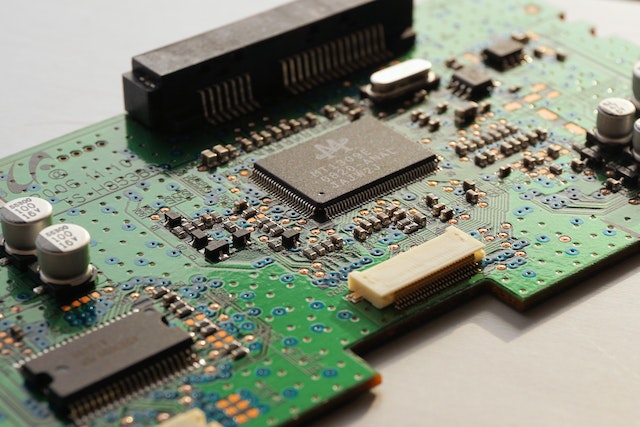Understanding Indium Phosphide: A Unique Semiconductor Material
Ensnared in the intricate web of semiconductor compositions, Indium Phosphide (InP) emerges as a binary compound – an intriguing fusion of indium and phosphorus. This peculiar concoction has set pulses racing within the corridors of the semiconductor industry, thanks to its array of extraordinary attributes. As a card-carrying member of III-V semiconductors, InP commands respect with its direct bandgap – a feature that distinguishes it from run-of-the-mill materials like silicon. The presence of this direct bandgap is instrumental in permitting effective emission or absorption of light, catapulting InP into the limelight for optoelectronic devices.

What sets Indium Phosphide apart on the vast stage filled with countless semiconductors is its ample energy gap, also known as ‘band gap’. A generous band gap ensures minimal intrinsic carrier concentrations at room temperature which translates into diminished noise levels in electronic merchandise. When pitted against Gallium Arsenide (GaAs), another frequent contender in semiconductor circles, InP steals the show with superior electron velocity leading to heightened frequency operation capabilities. These features earmark Indium Phosphide as an ideal choice for high-octane applications where speed and efficiency hold sway.
Quite often we find Indium Phosphide making appearances within electronics industry under disguise- transformed into an ‘InP wafer’. Serving as cornerstones for diverse high-power electronics and quantum contraptions owing to their optical properties and remarkable performance traits under severe conditions – these wafers are indispensable components. They extend olive branches towards existing silicon-based technologies while offering tantalizing prospects such as amplified speed and decreased power consumption; attributes much coveted in our rapidly evolving technological panorama.
The Band Gap: Indium Phosphide’s Key Feature
In a world of semiconductors, Indium Phosphide (InP) stands out with attributes uniquely its own that render it an exemplar for high-power electronics. Its distinct crystal structure and lattice arrangement are like no other, setting it on a pedestal apart from fellow semiconductors such as gallium arsenide (GaAs) and silicon. The gem in the crown of InP’s features is its band gap – this crucial energy difference between the upper echelon of the valence band and lower rung of the conduction band where electrons dance their electric jig.

The significance of indium phosphide’s bandgap lies not just in mere numbers or comparisons but in its profound impact on optical properties, particularly when employed in optoelectronics applications such as laser diodes and modulators. When compared to GaAs or silicon siblings, InP boasts a larger direct bandgap allowing effective emission or absorption of light – carving out a niche for itself as an ideal candidate for lasers and photodetectors. Moreover, if we were to pit an InP wafer against gallium arsenide wafers, our champion would exhibit superior electron velocity contributing to stellar high-frequency performance—a feature non-negotiable when selecting materials for advanced electronic devices.
Adding another layer to this intriguing narrative are certain specific compounds birthed by Indium Phosphide; one notable offspring being Indium Gallium Arsenide (InGaAs), extensively leveraged in spectroscopy applications due to its sensitivity spanning across various wavelengths. Another offspring worth lauding is Indium Iodide which forms part of white phosphorus detectors owing to their impressive thermal stability. These diverse compound creations do more than just serve varied purposes within electronics industry—they underscore how essential understanding the properties of indium phosphide can be instrumental towards unlocking its full potential within semiconductor technology landscape.
Gallium Arsenide Vs Indium Phosphide: A Comparative Study in Semiconductors
The realms of gallium arsenide and indium phosphide, both tantalising III-V binary semiconductor materials, are swathed in the enigmatic field of optoelectronics. A mysterious amalgamation of gallium and arsenic births Gallium Arsenide while an intriguing union between indium and phosphorus gives rise to Indium Phosphide. Each has its unique identity etched in their individual properties that deem them ideal for distinct roles within the high-power electronics theatre.
Indium Phosphide semiconductors possess a nuanced edge over their Gallium Arsenide counterparts, courtesy of superior electron velocity – a trait that earmarks them as prime candidates for high-frequency integrated circuits. The same quality also paints it as an enticing choice for solar cells where its direct band gap becomes instrumental in converting sunlight into electrical energy with efficiency. Moreover, exposure to exotic compounds such as white phosphorus and indium iodide during manufacturing processes can be meticulously managed to amplify its optical attributes further. On the other hand, Gallium Arsenide flaunts less direct but worthy energy gaps which find utility in certain quantum optoelectronic devices like laser diodes.
Marrying these two elements yields Indium Gallium Arsenide – a heterojunction bipolar transistor that cleverly draws upon the finest features from both parents. This hybrid offspring is extensively used in LEDs thanks to its prowess at emitting light across various wavelengths whilst maintaining stability under vigorous high-power operations. Furthermore, trialkyl indicum compound coupled with phosphine finds use during fabrication process bolstering performance output from these optoelectronic devices without losing sight of safety or environmental standards.
Optical Properties: The Role of Indium Phosphide in Optoelectronics
The compound semiconductor, indium phosphide – an amalgamation of indium and phosphorus – occupies a distinct position due to its defining attributes that outstrip traditional materials like silicon and gallium arsenide. It’s especially pronounced in realms where high-power and high-frequency electronics are indispensable. Its energy band structure is remarkable, particularly when considering the alignment of valence and conduction bands which paves the way for efficient electron flow – an element critical for devices such as heterojunction bipolar transistors where superior frequency performance takes precedence.
The nanocrystalline surface of indium phosphide serves to augment its optoelectronic properties further. By employing methods like thermal decomposition or electrochemical etching, it is possible to realize a nanocrystalline surface that carries with it smaller lattice constants which contribute towards diminishing defects at atomic levels – thereby enhancing overall device performance. However, despite these advantageous features inherent in InP semiconductors, caution must be exercised because exposure to Indium Phosphate may precipitate health hazards such as pulmonary edema.
Beyond its commendable electronic properties, another pivotal role played by indium phosphide pertains to optoelectronics wherein it exhibits a superb ability in converting electrical signals into optical ones efficiently – this property being absolutely essential for contemporary communication systems including fiber optic networks. As such, InP enjoys widespread usage across several optoelectronic devices not just on account of these inherent qualities but also due to other significant characteristics like stability under intense power conditions and compatibility during integration with other materials through techniques involving mixture processes using a trialkyl indium compound during fabrication stages.
InP Wafers: The Building Blocks of High-Power Electronics
In the realm of high-power electronics, Indium Phosphide (InP) wafers, a kin of the III-V semiconductor family, are progressively staking their claim as a keystone. Their supremacy in electron velocity sets them apart from more ubiquitous semiconductors such as silicon and gallium arsenide. These coveted wafers materialize through thermal decomposition of an amalgamation comprising indium iodide at 400 °C and white phosphorus, yielding a semiconductor crystal that is notably precise and compact compared to its counterparts – an attribute that renders it beneficial for optoelectronics contrivances like lasers or solar cells.
The edge InP holds over standard semiconductors like silicon and gallium arsenide stems from its distinct optical properties. Scrutiny under a scanning electron microscope uncovers that InP’s band gap empowers it to function within the whopping 604 GHz frequency range – significantly surpassing what most conventional materials can muster. This endows it with suitability for deployment in optoelectronic components where rapid data transmission is paramount. Beyond this, these qualities also transform Indium Phosphide quantum dots into highly potent light emitters which could potentially form the groundwork for future display technologies.
But InP wafer’s acumen isn’t confined solely to optoelectronics; they’ve carved out significant territory across diverse semiconductor applications due to their standout features. Notably characterized by superior electron velocity when squared against commonly used materials – this singular trait has catapulted them into high demand within industry circles. Additionally, their resilience under severe operating conditions combined with consistent delivery of stellar performance over time means Indium Phosphide wafers continue garnering interest both commercially and academically on a global scale.




Comments are closed.